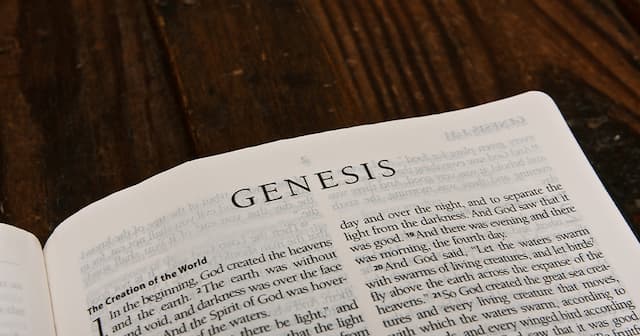Son of Man in Enoch
Did any texts refer to a messianic figure as “the son of man” before the Gospels? There may have been.
Jesus designated himself “the son of man” more than 80 times according to the Gospels, even though this phrase was not a messianic title in Jewish literature before his time. But there may be an intriguing exception: a book known as 1 Enoch.
This book was so popular that it has been treated as Scripture (Ethiopian church, Mormans). It’s quoted in the New Testament (Jude 9), and it was popular with some of the church fathers. It’s apocalyptic in style, and it’s part of the Pseudepigrapha.
The Book of Enoch is a compilation of five works. The oldest may date back to the Persian era (fourth century BC). The most recent section (chapters 37 – 71) is known as the Similitudes of Enoch, or Parables of Enoch. It’s generally dated to the early first century, i.e. at a similar time to the life of Jesus.
The intriguing bit is that the Similitudes refer to a messianic figure as the son of man. Here’s a sample:
1 Enoch 46:1-4 (Charlesworth translation)
1 At that place, I saw the One to whom belongs the time before time. And his head was white like wool, and there was with him another individual, whose face was like that of a human being. His countenance was full of grace like that of one among the holy angels. …
2 And I asked the one—from among the angels … “Who is this …?”
3 And he answered me and said to me, “This is the Son of Man, to whom belongs righteousness …
4 This Son of Man whom you have seen is the One who would remove the kings and the mighty ones from their comfortable seats and the strong ones from their thrones.
The references to the Son of Man in 1 Enoch clearly draw from Daniel 7. The “Ancient of Days” is the one who belongs before time. The one who is like a human is then called Son of Man, and the kingdom is given to him so he dethrones their enemies.
At the very end of the Similitudes, the identity of the Son of Man is revealed. It’s Enoch — the guy giving this revelation:
1 Enoch 71:14 (Charlesworth)
Then an angel came to me and greeted me and said to me, “You, son of man, who art born in righteousness and upon whom righteousness has dwelt, the righteousness of the Antecedent of Time will not forsake you.”
Whether this verse was added to the text of Enoch later or not, it’s an idea that comes from Daniel 8:17 where an angel addresses Daniel as “son of man.”
How intriguing! We have another text, outside the Gospels, about the son of man. What’s the connection? Scholars have weighed several possibilities:
- Did Jesus (and the Gospel writers) draw inspiration from 1 Enoch?
- Did 1 Enoch draw inspiration from Jesus?
- Did Jesus and 1 Enoch both draw inspiration from oral ideas that were present in their culture?
- Did Jesus and 1 Enoch both independently draw inspiration from Daniel?
The problem with (a) and (b) is that we can’t date the Similitudes precisely enough to know for sure, but neither seems to have been around long enough to provide the influence to the other. Remember, there’s no internet, no printing press. Hand-copied texts spread slowly. Even when the Qumran community saved 20 copies of Enoch around AD 68, they didn’t have any copies of the Similitudes.
The problem with (c) is the lack of any other evidence of this idea circulating widely in the early first century. Examples like John 12:34 suggest that the son of man phrase was not widely understood in this way. Given the current scholarship, I find (d) most plausible.
If that conclusion is right, Jesus did not draw from the 1 Enoch tradition for his self-understanding, but he did draw (at least in part) on Daniel 7, as did the Similitudes. In any case, 1 Enoch provides an example of how others in the first century could conceive of the son of man as a messianic figure, based on Daniel 7.
What others are saying
James H. Charlesworth and Darrell L. Bock, “Conclusion,” in Parables of Enoch: A Paradigm Shift, (New York: Bloomsbury, 2013), 371:
These chapters represent a burgeoning consensus that the ideas in the Parables of Enoch influenced the Palestinian Jesus Movement. Some of the chapters also present a specific hypothesis that this material had its origin in Galilee somewhere around the turn of the era after 37 BCE and before the beginning of Jesus’ ministry.
Martin Abegg Jr., Peter Flint, and Eugene Ulrich, The Dead Sea Scrolls Bible, (New York: HarperOne, 1999), 481:
Another mystery that the scrolls have only clouded concerns the origin of the important and frequent (88x) New Testament title for Jesus: Son of Man (e.g., Matt 12:32). I Enoch 37–71 also features a messianic character of this name. As noted, this section has not been found among the scroll fragments, giving rise to the speculation that the New Testament influenced the final form 1 Enoch rather than the reverse.
George W. E. Nickelsburg and James C. VanderKam, 1 Enoch 2: A Commentary on the Book of 1 Enoch, Chapters 37–82, Hermeneia (Minneapolis, MN: Fortress Press, 2012), 62–63:
With these considerations in place, I date the Parables between the latter part of Herod’s reign and the early decades of the first century c.e., with some preference for the earlier part of this time span.
[previous: Son of Man in Daniel]
[next: Son of Man in Ezekiel]
Seeking to understand Jesus in the terms he chose to describe himself: son of man (his identity), and kingdom of God (his mission). Riverview College Dean
View all posts by Allen Browne






